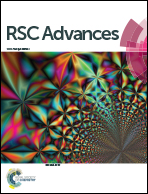A facile method for the synthesis of CuInS2–ZnS quantum dots with tunable photoluminescent properties
Abstract
CuInS2 quantum dots were synthesized via a solvothermal approach by heating up a mixture of the corresponding metal precursors and dodecanethiol in octadecene. By coating ZnS shells around the CuInS2 quantum dot cores directly in a pristine reaction solution, we successfully synthesized CuInS2–ZnS quantum dots with good monodispersion, spherical morphology and a diameter of 7 nm on average. The absorption and PL emission spectra of the CuInS2 QDs were controllable from 600 nm to 550 nm and from 670 nm to 600 nm, respectively. With the growth of ZnS, the percentage of internal defect recombination increased, which lead to the enhancement of PL intensity of CuInS2–ZnS QDs. The PL intensity and peak position of CuInS2 and CuInS2–ZnS QDs could also be tuned by varying the excitation wavelength. Besides, the reaction temperature and time play important roles on the photoluminescent properties of the CuInS2–ZnS quantum dots. This line of research finds feasible approaches to prepare CuInS2–ZnS quantum dots with great controllable photoluminescent properties. The CuInS2–ZnS quantum dots could greatly contribute to the development of quantum dot light-emitting diode (QLEDs) devices and other potential applications due to their non-toxicity and excellent optical properties.


 Please wait while we load your content...
Please wait while we load your content...